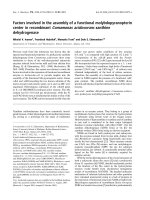báo cáo hóa học: " Topological confinement in an antisymmetric potential in bilayer graphene in the presence of a magnetic field" pptx
Bạn đang xem bản rút gọn của tài liệu. Xem và tải ngay bản đầy đủ của tài liệu tại đây (852.46 KB, 10 trang )
NANO EXPRESS Open Access
Topological confinement in an antisymmetric
potential in bilayer graphene in the presence of a
magnetic field
Mohammad Zarenia
1
, Joao Milton Pereira Jr
2*
, François Maria Peeters
1,2
and Gil de Aquino Farias
2
Abstract
We investigate the effect of an external magnetic field on the carrier states that are localized at a potential kink
and a kink-antikink in bilayer graphene. These chiral states are localized at the interface between two potential
regions with opposite signs.
PACS numbers: 71.10.Pm, 73.21 b, 81.05.Uw
Introduction
Carbon-based electronic structures have been the focus of
intense research since the discovery of fullerenes and car-
bon nanotubes [1]. More recently, the production of
atomic layers of hexagonal carbon (graphene) has renewed
that interest, with the observation of striking mechanical
and electronic properties, as well as ultrarel ativistic-lik e
phenomena in condensed matt er systems [2-4]. In that
context, bilayer graphene (BLG), which is a system with
two coupled sheets of graphene, has been shown to have
features that make it a possible substitute of silicon i n
microelectronic devices. The carrier dispersion of pristine
BLG is gapless and approximately parabolic at two points
in the Brillouin zone (K and K’). However, it has been
found that the application of perpendicular electric fields
produced by external gates deposited on the BLG surface
can induce a gap in the spectrum. The electric field creates
a charge imbalance between the la yers which leads to a
gap in the spectrum [5,6]. The tailoring of the gap b y an
external field may be particularly useful for the develop-
ment of devices. It has been recently re cognized that a
tunable energy gap in BLG can allow the observation of
new confined electronic states [7,8], which could be
obtained by applying a spatially varying potential profile to
create a position-dependent gap analogous to semiconduc-
tor heterojunctions.
An alternative way to create one dimensi onal localized
states in BLG has recently been suggested by Martin et al.
[9] and relies on the creation of a potential “kink” by an
asymmetric potential profile (see Figure 1). It has been
shown that localized chiral states arise at the location of
the kink, with energies inside the energy gap. These states
correspond to u ni-directional motion of electrons which
are analogous to the edge states in a quantum Hall system
and show a valley-dependent propagation along th e kink.
From a practical standpoint, the kinks may be envisaged
as configurable metallic nanowires embedded in a semi-
conductor medium. Moreover, t he carrier states in this
system are expected to be robust with regards to scattering
and may display Luttinger liquid behavior [10]. Such kink
potentials can be realized in e.g. p-n junctions. Recently
the transport properties of p-n-p junctions in bilayer gra-
phene were investigated experimentally in the presence of
a perpendicular magnetic field [11].
An additional tool for the manipulation of charge
states is the use of magnetic fields. The application of
an external magnetic field perpendicular to the BLG
sheet causes the appearance of Landau levels which can
be significantly modified by the induced gap, leading to
effect s such as the lifting of valley degeneracy caused
by the breaking of the inversion symmetry due to the
electrostatic bias [12,13]. The presen ce of a magnetic
field in conjunction with electrostatic potential barriers
in BLG has been shown to lead to a r ich set of beha-
viors in which Landau quantization competes with the
electrostatic confinement-induced quantization [14].
* Correspondence:
2
Departamento de Física, Universidade Federal do Ceará, Fortaleza, Ceará,
60455-760, Brazil
Full list of author information is available at the end of the article
Zarenia et al. Nanoscale Research Letters 2011, 6:452
/>© 2011 Za renia et al; licensee Spring er. This is an Open Access article distribut ed under the terms of the Creative Common s Attribution
License ( which permits unrestricted use, distribution, and reproduction in any medium,
provided the original work is properly cited.
In the present work we investigate the properties of
localized states in a kink potential profile under a per-
pendicular external magnetic field, both for the case of a
single potential kink, as well as fo r a kink-antikink pair.
One advantage of such a setup is the fact that in an
experimental realization of this system the number of
one-dimensional metallic channels and their sub sequent
magnetic response can be configurable, by controlling
the gate voltages. As shown by our n umerical results,
the influence of the magnetic field can be strikingly di s-
tinct for single and double kinks.
Model
We employ a reduced two-band continuum model to
describe the BG sheet. In this model, the system is
describedbyfoursublatticesintheupper(A, B)and
lower ( A’ and B’) layers [2]. The interlayer coupling is
given by the hopping parameter t ≈ 400 m eV between
sites A and B’. The Hamiltonian around the K valley of
the first Brillouin zone can be written as
H = −
1
t
0(π
†
)
2
(π)
2
0
+
U(x )0
0 −U(x)
(1)
where π = v
F
( p
x
+ ip
y
), p
x, y
=-iħ∂
x,y
+ eA
x,y
is the
momentum operator in the presence of an external
magnetic field with A
x,y
being the components of the
vector potential A, v
F
=10
6
m/s is the Fermi velocity, U
(x)and-U(x) is the electrost atic potential applied to the
upper and lower layers, respectively. The e igenstates of
the Hamiltonian Eq. (1) are two-component spinors
Ψ(x, y)=[ψ
a
(x, y), ψ
b
(x, y)]
T
,whereψ
a,b
are the envel-
ope functions associated with the probability am plitudes
at sublattices A and B’ at the respective layers of the
BLG sheet. We notice that [H, p
y
] = 0 and co nsequently
the momentum along the y direction is a conserved
quantity and therefore we can write,
ψ(x, y)=e
ik
y
y
ϕ
a
(x)
ϕ
b
(x)
(2)
where, k
y
are the wave vector along the y direction.
When applying a perpendicular magnetic field to the
bilayer sheet we employ the Landau gauge for the vector
potential A =(0,B
0
x , 0). The Hamiltonian (1) acts o n
the wave function of Eq. (2) which leads to the following
coupled second-order differential equations,
[
∂
∂x
+(k
y
+ βx
)]
2
ϕ
b
=[ε − u(x
)]ϕ
a
,
(3a)
[
∂
∂x
− (k
y
+ βx
)]
2
ϕ
a
=[ε + u(x
)]ϕ
b
.
(3b)
B
Bila
y
er
g
raphene
+
_
_
+
E
e
E
e
Figure 1 (Color online) Schematic illustration of the bilayer graphene device for the creation of a kink potential. Applied gated voltage
to the upper and lower layers with opposite sign induce a spacial dependent electric field E
e
. An external magnetic field
B = B
0
ˆz
, is applied
perpendicular to the bilayer graphene sheets.
Zarenia et al. Nanoscale Research Letters 2011, 6:452
/>Page 2 of 10
where, in the above equations we used the dimension-
less units l = ħv
F
/t = 1.6455 nm, x’ = x/l,
k
y
= k
y
l
, ε =
E/t, u(x’ )=U(x)/t, b =[eB
0
/ħ]l
2
(= 0.0041 for B
0
=1T).
The step-like kink (see Figure 1) is modeled by,
u(x
)=u
b
tanh(x
/δ), −∞ < x
< ∞
(4)
where, u
b
is the maximum val ue of the gate voltage in
dimensionless unit in each BLG layer. Here, δ denotes
the width of the region in which the potential switches
its sign in each layer. This parameter is determined by
the distance between the gates used to create the energy
gap. We solved numerically Eqs. (3) using the finite ele-
ment technique to obtain the the spectrum as function
of the magnetic field and the potential parameters.
I. Numerical Results
Figure 2(a) shows the spectrum for a pot ential kink as
function of the wavevector along the kink for zero mag-
netic field. In this case, the potential kink is sharp, i.e. δ =
1 in Eq. (4). It is seen that the solutions of Eq. (3) for B
0
=
0 are related by the transformations j
a
® - j
b
, j
b
® j
a
,
k
y
® - k
y
and ε ® -ε. The shaded region corresponds to
the continuum of free states. The dashed horizontal lines
correspond to ε =±u
b
and ε =0,withu
b
= 0.25. These
results are found in the vicinity of a single valley (K) and
show the unidirectional character of the propagation, in
which only states with positive group velocity are obtained.
Notice that the spectrum has the property
E(k
y
)=−E(−k
y
)
. For localized states around the K’ valley,
we have E
K’
(k
y
)=-E
K
(k
y
). Panels (b) and (c) of Figure 2
present the spinor components and the probability density
for t he states i ndicated by the arrows in panel (a), corre-
sponding to
k
y
= −0.28
(b) and
k
y
=0.2
8
(c). These elec-
tron states are localized at the potential kink.
Figure 3 shows the dependence of the single k ink
energies on the external magnetic field for (a)
k
y
=0
and (b)
k
y
=0.15
. The branches that appear for |E/t |>
0.25 correspond to Landau levels that arise from the
continuum of free states. It is seen that the spectrum of
confined states is very weakly influenced by the mag-
netic field. That is a conseq uence of the strong confine-
ment of the states in the kink potential. In a
semiclassical view, the movement of the carri ers is con-
strained by the potential, which prevents the formation
of cyclotron orbits.
We also calculate the oscillator strength for electric
dipole transitions between the topological energy levels.
The oscillator strength |<ψ*|re
iθ
| ψ>|
2
is given by
| <ψ
†
|x|ψ>|
2
=
i
ϕ
∗
i
(x
)x
ϕ
i
(x
)dx
2
(5)
where, i = a, b. Figure 4 shows the oscillator strength
and the corresponding transition energy ΔE for the
topological states of a single kink profile. The results are
presented as function of
k
y
(panels (a,c)) and the exter-
nal magnetic field (panels (b,d)). The topological states
are indicated by (1), (2) i n Figure 2(a). The
E(k
y
)=−E(−k
y
)
property of the topological levels leads
to a symmetric behavior around
k
y
=0
for the oscillator
strength. T he results in Figure 4(a) show a zero value
for the oscillator strength at
k
y
=0
.Asshowninthe
inset of Figure 4(a) the wavespinors for the first state
ϕ
a
1
,b
1
and the second one
ϕ
a
2
,b
2
at
k
y
=0
are related as
ϕ
a
1
= −ϕ
b
2
and
ϕ
b
1
= ϕ
a
2
which results | <ψ
†
| x |ψ >|
2
= 0 in Eq. (5). Panel 4(b) presents the oscillator
strength as function of magnetic field for several values
of
k
y
. The presence of an external magnetic field
decreases the oscillator strength at la rge momentum
whereas the B
0
= 0 result exhibits an increase in the
oscillator strength (blue dashed curve in (a)). The reason
is that a large magnetic field together with a large
momentum weakly affects the topological states of the
single kink profi le ( see Figur e 3(b)). Note that the oscil-
lator strength vs magnetic field is zer o for
k
y
=0
(dotted line in panel (b)).
Next we con sidered a potential profile with a kink-
antikink. Figure 5 shows the spectrum of localized states
for B
0
= 0 ( a) and B
0
= 3 T (b). The results show a shift
of the four mid-gap energy branches as the magnetic
field i ncreases. In addition, the continuum of free states
at zero magnetic field is replaced by a set of Landau
levels for ε >u
b
. The spinor components and probability
densities associated with the points indicated by arrows
in Figu re 5(a) and Figure 5(b) are shown in Figure 6. In
Figure 6(a) the wavefunction shows the overlap between
states loca lized in both the kink and antikink, for zero
magnetic field. With increasing wavevector, the states
become strongly localized in either the kink (b) or anti-
kink (c). Panels (d) to (f) show the wavefunctions for
non-zero magnetic field. The states at
k
y
=0
, (panel (d))
show a shift of the probability density towards the cen-
tral re gion of the potential. That is caused by the addi-
tional confinem ent brought about by the magneti c field.
However, for a larger value of the wavevector, th e wave-
functions are only weakly affected by the field, due to
the strong localization of the states.
Figure 7 displays the energy levels of a kink-antikink
potential as function of an external magnetic field for
(a)
k
y
=0
and (b)
k
y
=0.2
. For the kink-antikink case,
the overlap between the states associated with each con-
finement region allows the formation of Landau orbits.
Therefore, in contrast to the single kink profile, the
Zarenia et al. Nanoscale Research Letters 2011, 6:452
/>Page 3 of 10
(1)
(2)
Figure 2 Energy le vels for a single kink profile on bilayer graphene in the absenc e of magnetic field with u
b
= 0.25 and δ =1.The
right panels show the wave spinors and probability density corresponding to the states that are indicated by arrows in panel (a).
(a)
(b)
Figure 3 Energy levels of a single kink profile in bilayer graphene as function of external magnetic field B
0
with the same parameters
as Fig. 2 for (a)
k
y
=0
and (b)
k
y
= 0.1
5
.
Zarenia et al. Nanoscale Research Letters 2011, 6:452
/>Page 4 of 10
proximity of an antikink induces a strong dependence of
the states on the external field.
The localization of the states is reflected in the posi-
tion dependence of the current. The current in the y-
direction is obtained using
j
y
= iv
F
[
†
(∂
x
σ
y
− ∂
y
σ
x
) +
T
(∂
x
σ
y
+ ∂
y
σ
x
)
∗
]
(6)
where
(
x, y
)
= e
ik
y
y
[ϕ
a
(
x
)
, ϕ
b
(
x
)
]
T
.werewriteEq.(6)
in the following form
j
y
=2v
F
[Re{ϕ
∗
a
∂
x
ϕ
b
− ϕ
∗
b
∂
x
ϕ
a
} +2k
y
Re{ϕ
∗
a
ϕ
b
}].
(7)
The x-component of the current vanishes for the con-
fined states. It should be noticed that a non-zero current
can be found for E = 0, as can be deduced from the
0
0.05
0.1
0.15
0.2
Oscillator strength
−0.2 −0.1 0 0.1 0.2
0.29
0.3
0.31
0.32
0.33
k
y
l
ΔE
/
t
−10 0 10
B
0
(
T
)
−15 0 15
x/l
(b)
(d)
(c)
(a)
B
0
=5T
B
0
=0T
k
y
=0.15
k
y
=0.1
k
y
=0
ϕ
a
1
ϕ
b
1
ϕ
a
2
,
ϕ
b
2
Figure 4 (Color online) Oscillator strength for the transition between the topological states of the single kink profile (The states are
labeled by (1), (2) in Fig. 2) and the corresponding transition energies ΔE as function of (a,c) the y-component of the wavelength
k
y
= k
y
l
and (b,d) the external magnetic field B
0
. The inset in (a) shows the wavespinors for k
y
l =0.
Zarenia et al. Nanoscale Research Letters 2011, 6:452
/>Page 5 of 10
dispersion relations. Figure 8 shows plots of the y-com-
ponent of the current density as function of x for the
states labelled (1) to (6) in panels (a) and (b) of Figure
7. For
k
y
=0
the results presented in Fi gure 8(a) show a
persistent current carried by each kink region, irrespec -
tive of the direction of B
0
, a s exemplified by the states
(1) and (2) which correspond to opposite directions of
magnetic field. For non-zero wave vectors, however, as
(1)
(2)
(3)
Figure 5 Energy levels of a kink-antikink profile on bilayer graphene with u
b
=0.25andδ =1for(a)B
0
=0T and (b) B
0
=3T.The
kinks are located at x’ = ±15 (or x ≈ ±25nm in real units).
Zarenia et al. Nanoscale Research Letters 2011, 6:452
/>Page 6 of 10
shown in panels (b) and (c), the current is strongly loca-
lized around either potential kink. In Figure 8(b), the
density current curve shows an additional peak caused
by a stronger magnetic field (B
0
≈ 10 T ).
Figure 9 displays the oscillator strength and the corre-
sponding transition energy for the m id-gap levels of the
kink-antikink potentials as function of (a, c)
k
y
and (b,d)
external magnetic field B
0
(the energy branches are
labeled by (1), ( 2), (3) in Figure 5(a)) . The wavefunction
for the energies corresponding to the kink states (1), (3)
are localized around x’ = d whereas the antikink energy
levels confine the carriers around x =-d and conse-
quently the oscillator strength by the transition between
the kink and the antikink states (e.g. 1 ® 2) is zero in
-0.4
-0.2
0
0.2
0.4
0
0.1
0.2
0.3
0.4
-20 0 20
-0.2
-0.1
0
0.1
0.2
-20 0 20
B
0
=0T
B
0
=3T
(a)
(b)
(f)
(e)
( )
c
(d)
xl
j
a
|Y|
2
xl
j
b
k
y
=0
k
y
=0.25
k
y
=0.31
k
y
=0.2
k
y
=0.27
k
y
=0
Figure 6 Wave spinors,
a
,
b
and the corresponding probability density for the points in the energy spectrum which are indicated in
Fig. 5 by arrows.
Zarenia et al. Nanoscale Research Letters 2011, 6:452
/>Page 7 of 10
the absence or either presence of magnetic field (blue
solid curves in p anels (a,b)). The inset of panel (a) indi-
cates that the wavespinors satisfy the
ϕ
a
1
= ϕ
b
3
and
ϕ
b
1
= −ϕ
a
3
relations at
k
y
=0
and B
0
= 0 which leads to
a zero oscillator strength for the 1 ® 3 transition. In
contrast to the single kink profile the shift in the intra-
gap energies of the kink-antikink potential leads to a
non-zero value for the o scillator strength at
k
y
=0
(red
solid curve in (a)). The oscillator strength as function of
the external magnetic field is shown in panel (b) for
k
y
=0.1
. T he inset in panel (b) shows the wavefunction
of the state s (1) and (3) at B
0
≈ 1.6 T where, the same
relations as f or the single kink potential between the
wavespinors (
ϕ
a
1
= −ϕ
b
3
and
ϕ
b
1
= ϕ
a
3
) leads to a zero
value for the oscillator strength.
Conclusions
We obtained the spectrum of electronic bound states that
are localized at potential kinks in bilayer graphene, which
can be created by antisymmetric gate potentials. For a
single potential kink, the bound states are only weakly
influenced by an external magnetic field, due to their
one-dimensional character, caused by the strong confine-
ment along the direction of the potential kink interface.
For a kink-antikink pair, however, the numerical results
show a significant shift of the carrier dispersion, which
(b)
(a)
Figure 7 Energ y levels of a kink-an tiki nk profile in bilayer graphene as funct ion of external magnetic field B
0
for (a)
k
y
=0
and (b)
k
y
= 0.
2
. The other parameters are the same as Fig. 5.
−0.02
−0.01
0
0.01
0.02
j
y
/
v
F
−0.04
−0.02
0
0.02
0
.
04
j
y
/v
F
−20 −15 −10 −5 0 5 10 15 20
−0.1
−0.05
0
0.05
0.1
x
/
l
j
y
/v
F
(4)
(5)
(6)
k
y
=0.2
k
y
=0.2
k
y
=0
(1), (2)
(3)
(a)
(b)
(c)
Figure 8 y component of the Persistent curren t in bilayer
graphene as function of x direction for the values of magnetic
field where E = E
F
which are indicated by (1), (2), in Fig. 7(a),
(b).
Zarenia et al. Nanoscale Research Letters 2011, 6:452
/>Page 8 of 10
arises due to the coupling of the states localized at either
potential interface. Therefore, such configurable kink
potentials in bilayer graphene permits the tailoring of the
low-dimensional carrier dynamics as well as its magnetic
field response by means of gate voltages.
Acknowledgements
This work was supported by the Brazilian agency CNPq (Pronex), the Flemish
Science Foundation (FWO-Vl), the Belg ian Science Policy (IAP), and the
bilateral projects between Flanders and Brazil and FWO-CNPq.
Author details
1
Department of Physics, University of Antwerp, Groenenborgerlaan 171, B-
2020 Antwerpen, Belgium
2
Departamento de Física, Universidade Federal do
Ceará, Fortaleza, Ceará, 60455-760, Brazil
Authors’ contributions
MZ carried out the numerical results JMP Jr and FMP were involved in the
conception of the study and performed the sequence alignment and
drafted the manuscript. GAF contributed in analysis of the numerical results.
All authors read and approved the final manuscript.
Competing interests
The authors declare that they have no competing interests.
0
0.05
0.1
0.15
0
.
2
osci
ll
ator strengt
h
−0.1 0 0.1
0
0.1
0.2
0.3
k
y
l
ΔE/t
−2 0 2 4
B
0
(
T
)
−15 0 15
−15 0 15
B
0
=0, 3 T
(b)
1 → 2
1 → 3
1 → 2
(d)
(c)
(a)
1 → 3
1 → 2
1 → 2
B
0
=3T
B
0
=0T
k
y
=0.1
ϕ
a
1
,
ϕ
a
3
ϕ
b
3
ϕ
b
1
ϕ
b
3
ϕ
a
1
ϕ
a
3
,
ϕ
b
1
1 → 3
1 → 3
Figure 9 (Color online) (a,b) Oscillator strength and (c,d) the corresponding transition energies ΔE for the 1 ® 2 (blue curves) and 1
® 3 (red curves) transitions between the intragap energy states of the kink-antink profile as function of (a,c)
k
y
and (b,d) the external
magnetic field B
0
(the energy levels are labeled by (1), (2), (3) in Fig. 5(a)). Dashed curves and solid curves in panels (a,c) display the results
respectively for a zero and non-zero magnetic field. The insets in panels (a),(b) show the wavespinors of the levels (1) and (3) corresponding to
the points with zero oscillator strength.
Zarenia et al. Nanoscale Research Letters 2011, 6:452
/>Page 9 of 10
Received: 16 September 2010 Accepted: 14 July 2011
Published: 14 July 2011
References
1. Saito R, Dresslhaus G, Dresselhaus MS: Physical Properties of Carbon
Nanotubes. Imperial College Press, London; 1998.
2. Castro Neto AH, Guinea F, Peres NMR, Novoselov KS, Geim A: The
electronic properties of grapheme. Rev Mod Phys 2009, 81:109.
3. Li X, Wang X, Zhang Li, Lee S, Dai H: Chemically Derived, Ultrasmooth
Graphene Nanoribbon Semiconductors. Science 2008, 319:1229.
4. Ohta T, Bostwick A, Seyller T, Horn K, Rotenberg E: Controlling the
Electronic Structure of Bilayer Graphene. Science 2006, 313:951.
5. McCann E: Asymmetry gap in the electronic band structure of bilayer
grapheme. Phys Rev B 2006, 74:161403.
6. Castro VEduardo, Novoselov KS, Morozov SV, Peres NMR, Lopes dos
Santos JMB, Nilsson Johan, Guinea F, Geim AK, Castro Neto AH: Biased
Bilayer Graphene: Semiconductor with a Gap Tunable by the Electric
Field Effect. Phys Rev Lett 2007, 99:216802.
7. Pereira JM Jr, Vasilopoulos P, Peeters FM: Tunable Quantum Dots in
Bilayer Graphene. Nano Lett 2007, 7:946.
8. Zarenia M, Pereira JM Jr, Peeters FM, Farias GA: Electrostatically Confined
Quantum Rings in Bilayer Graphene. Nano Lett 2009, 9:4088.
9. Martin I, Blanter MYa, Morpurgo AF: Topological Confinement in Bilayer
Graphene. Phys Rev Lett 2008, 100:036804.
10. Killi M, Wei T-C, Affleck I, Paramekanti A: Tunable Luttinger Liquid Physics
in Biased Bilayer Graphene. Phys Rev Lett 2010, 104:216406.
11. Jing L, Velasco J Jr, Kratz P, Liu G, Bao W, Bockrath M, Lau CN: Quantum
Transport and Field-Induced Insulating States in Bilayer Graphene pnp
Junctions. Nano Lett 2010, 10:4775.
12. McCann E, Fal’ko VI: Landau-Level Degeneracy and Quantum Hall Effect
in a Graphite Bilayer. Phys Rev Lett 2006, 96:086805.
13. Pereira JM, Peeters FM, Vasilopoulos P: Landau levels and oscillator
strength in a biased bilayer of grapheme. Phys Rev B 2007, 76:115419.
14. Pereira JM, Peeters FM, Vasilopoulos P, Costa Filho RN, Farias GA: Landau
levels in graphene bilayer quantum dots. Phys Rev B 79:195403.
doi:10.1186/1556-276X-6-452
Cite this article as: Zarenia et al.: Topological confinement in an
antisymmetric potential in bilayer graphene in the presence of a
magnetic field. Nanoscale Research Letters 2011 6:452.
Submit your manuscript to a
journal and benefi t from:
7 Convenient online submission
7 Rigorous peer review
7 Immediate publication on acceptance
7 Open access: articles freely available online
7 High visibility within the fi eld
7 Retaining the copyright to your article
Submit your next manuscript at 7 springeropen.com
Zarenia et al. Nanoscale Research Letters 2011, 6:452
/>Page 10 of 10









